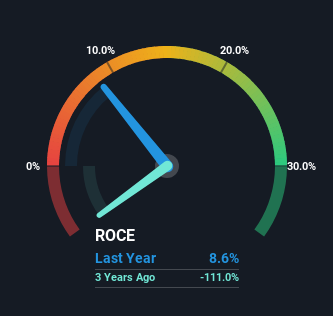- United States
- /
- IT
- /
- NasdaqCM:TAOP
Taoping (NASDAQ:TAOP) Is Doing The Right Things To Multiply Its Share Price
To find a multi-bagger stock, what are the underlying trends we should look for in a business? Firstly, we'd want to identify a growing return on capital employed (ROCE) and then alongside that, an ever-increasing base of capital employed. Ultimately, this demonstrates that it's a business that is reinvesting profits at increasing rates of return. So on that note, Taoping (NASDAQ:TAOP) looks quite promising in regards to its trends of return on capital.
Understanding Return On Capital Employed (ROCE)
For those who don't know, ROCE is a measure of a company's yearly pre-tax profit (its return), relative to the capital employed in the business. Analysts use this formula to calculate it for Taoping:
Return on Capital Employed = Earnings Before Interest and Tax (EBIT) ÷ (Total Assets - Current Liabilities)
0.086 = US$1.4m ÷ (US$34m - US$18m) (Based on the trailing twelve months to June 2024).
Thus, Taoping has an ROCE of 8.6%. Ultimately, that's a low return and it under-performs the IT industry average of 11%.
See our latest analysis for Taoping

Historical performance is a great place to start when researching a stock so above you can see the gauge for Taoping's ROCE against it's prior returns. If you'd like to look at how Taoping has performed in the past in other metrics, you can view this free graph of Taoping's past earnings, revenue and cash flow.
What Does the ROCE Trend For Taoping Tell Us?
Shareholders will be relieved that Taoping has broken into profitability. The company was generating losses five years ago, but has managed to turn it around and as we saw earlier is now earning 8.6%, which is always encouraging. While returns have increased, the amount of capital employed by Taoping has remained flat over the period. So while we're happy that the business is more efficient, just keep in mind that could mean that going forward the business is lacking areas to invest internally for growth. So if you're looking for high growth, you'll want to see a business's capital employed also increasing.
Another thing to note, Taoping has a high ratio of current liabilities to total assets of 54%. This can bring about some risks because the company is basically operating with a rather large reliance on its suppliers or other sorts of short-term creditors. While it's not necessarily a bad thing, it can be beneficial if this ratio is lower.
Our Take On Taoping's ROCE
In summary, we're delighted to see that Taoping has been able to increase efficiencies and earn higher rates of return on the same amount of capital. And since the stock has dived 99% over the last five years, there may be other factors affecting the company's prospects. Still, it's worth doing some further research to see if the trends will continue into the future.
Taoping does come with some risks though, we found 5 warning signs in our investment analysis, and 4 of those are a bit concerning...
For those who like to invest in solid companies, check out this free list of companies with solid balance sheets and high returns on equity.
The New Payments ETF Is Live on NASDAQ:
Money is moving to real-time rails, and a newly listed ETF now gives investors direct exposure. Fast settlement. Institutional custody. Simple access.
Explore how this launch could reshape portfolios
Sponsored ContentValuation is complex, but we're here to simplify it.
Discover if Taoping might be undervalued or overvalued with our detailed analysis, featuring fair value estimates, potential risks, dividends, insider trades, and its financial condition.
Access Free AnalysisHave feedback on this article? Concerned about the content? Get in touch with us directly. Alternatively, email editorial-team (at) simplywallst.com.
This article by Simply Wall St is general in nature. We provide commentary based on historical data and analyst forecasts only using an unbiased methodology and our articles are not intended to be financial advice. It does not constitute a recommendation to buy or sell any stock, and does not take account of your objectives, or your financial situation. We aim to bring you long-term focused analysis driven by fundamental data. Note that our analysis may not factor in the latest price-sensitive company announcements or qualitative material. Simply Wall St has no position in any stocks mentioned.
About NasdaqCM:TAOP
Taoping
Provides cloud-app technologies for smart city IoT platforms, digital advertising delivery, and other internet-based information distribution systems in China.
Excellent balance sheet with low risk.
Similar Companies
Market Insights
Weekly Picks

Early mover in a fast growing industry. Likely to experience share price volatility as they scale


A case for CA$31.80 (undiluted), aka 8,616% upside from CA$0.37 (an 86 bagger!).


Moderation and Stabilisation: HOLD: Fair Price based on a 4-year Cycle is $12.08
Recently Updated Narratives

Airbnb Stock: Platform Growth in a World of Saturation and Scrutiny

Clarivate Stock: When Data Becomes the Backbone of Innovation and Law

Adobe Stock: AI-Fueled ARR Growth Pushes Guidance Higher, But Cost Pressures Loom
Popular Narratives


Crazy Undervalued 42 Baggers Silver Play (Active & Running Mine)


NVDA: Expanding AI Demand Will Drive Major Data Center Investments Through 2026


MicroVision will explode future revenue by 380.37% with a vision towards success
Trending Discussion


